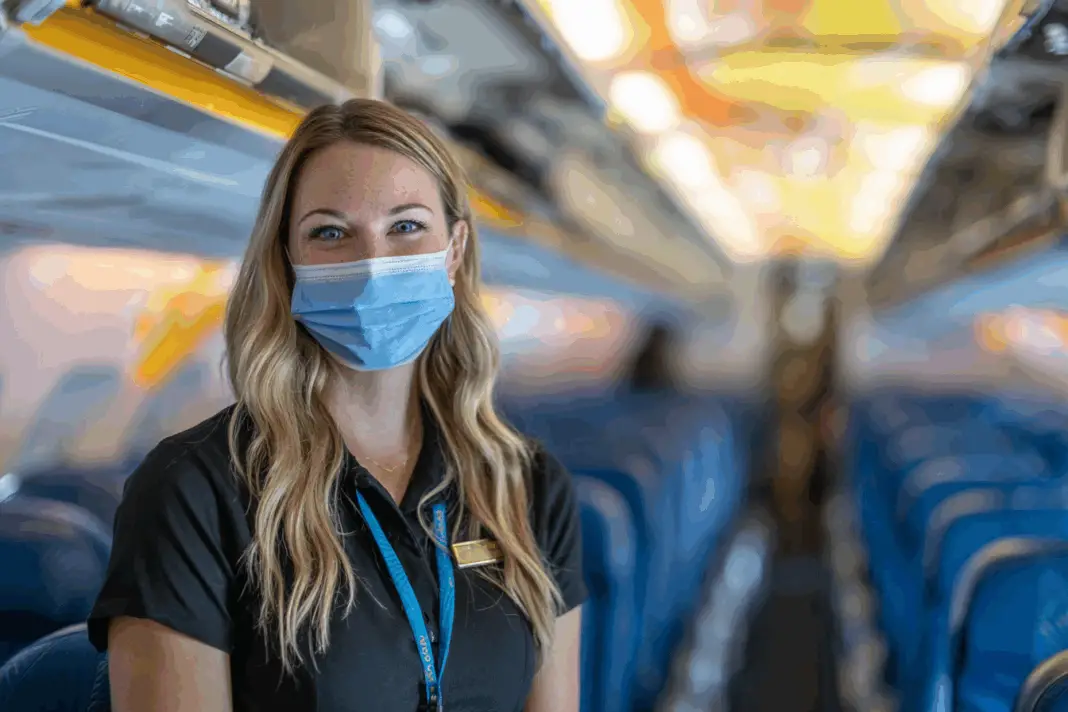Think becoming a flight attendant is just about serving drinks and smiling at passengers? Think again! Airlines have some seriously strange requirements that might surprise anyone considering this career. From height restrictions to swimming tests, these rules go way beyond what most people expect. The competition is fierce too – with less than 5% of applicants actually landing these positions, airlines can afford to be extremely picky about who they hire.
Height restrictions eliminate many qualified candidates
Airlines don’t just want friendly faces – they need people who can physically reach every part of the aircraft. Most carriers require flight attendants to be between 5 feet and 6 feet tall, with some being even more specific. Mesa Airlines demands applicants measure between 4 feet 11 inches and 6 feet exactly. This isn’t about looks – it’s pure practicality. Flight attendants need to reach overhead bins that can be nearly 7 feet high, and they also need to move comfortably through narrow cabin spaces without constantly ducking.
The reach test is where many hopeful candidates fail. Airlines require flight attendants to stretch their arms up to at least 6 feet 8 inches, sometimes while standing on their tiptoes. This ensures they can access safety equipment stored in high places and help passengers with heavy luggage. Some airlines allow high heels during the test, while others require bare feet. For shorter people, this requirement can be devastating – no amount of experience or personality can overcome failing the basic reach test that happens during the interview process.
Swimming ability determines job eligibility
When was the last time someone asked about swimming skills during a job interview? Flight attendants face exactly this question because airlines know that water landings, while rare, do happen. The requirement isn’t just being able to doggy paddle either. Air France requires certain applicants to swim 50 meters in just 90 seconds, which is actually quite fast for most recreational swimmers. This means treading water, potentially in rough conditions, while helping panicked passengers with life vests and emergency equipment.
The swimming test usually happens during training rather than the initial interview, but failing it means losing the job after weeks of preparation. Flight attendants need to demonstrate they can handle themselves in water because they might be the only trained personnel available to assist passengers during an ocean emergency. Not all airlines enforce this requirement equally – some domestic carriers that rarely fly over large bodies of water may be more lenient, while international airlines serving island destinations take it very seriously.
Dental braces can disqualify perfect candidates
Having braces might seem like a minor cosmetic issue, but many airlines treat it as a serious disqualifier. The reasoning goes beyond appearance – metal braces can become dangerous at high altitudes. When wires come loose, which happens unpredictably, they can cut the inside of the mouth and cause bleeding. Airlines like Emirates and Singapore Airlines won’t hire anyone with traditional metal braces because they consider them both a safety hazard and unprofessional looking.
Clear aligners like Invisalign might be acceptable to some carriers, but even that depends on company policy. The problem is that dealing with dental pain or bleeding becomes much more complicated when trapped in a metal tube at 35,000 feet for hours. There’s no dentist available, and the flight attendant needs to maintain focus while serving passengers and handling potential emergencies. Most North American and European airlines are more relaxed about this rule, but Asian and Middle Eastern carriers often maintain strict no-braces policies that eliminate otherwise qualified applicants.
Perfect skin becomes a job requirement
Imagine being rejected from a job because of a few pimples or acne scars. That’s reality for flight attendant applicants at certain airlines that demand flawless complexions. AirAsia specifically lists “flawless skin without acne marks” as a requirement in their job postings. Air India goes even further, stating in their handbook that clear, acne-free skin is a prerequisite for flight duties. These standards put enormous pressure on applicants who might otherwise excel at customer service and safety procedures.
The reasoning behind these requirements centers on the flight attendant’s role as the face of the airline. Since passengers interact more with cabin crew than any other airline employee, carriers want them to project an image of health and professionalism. Some airlines even provide extensive skincare training during orientation, teaching new hires about the effects of cabin air on skin and proper cleansing routines. While most Western airlines don’t explicitly require perfect skin, they do emphasize good grooming and may suggest makeup to cover minor imperfections.
Visible tattoos eliminate job prospects immediately
Despite tattoos becoming mainstream in American culture, most airlines still treat them like career killers for flight attendants. American Airlines and Delta both prohibit any visible body art while in uniform, meaning tattoos on hands, arms, legs, or neck are automatic disqualifiers. The policies are so strict that even small tattoos that could be covered by makeup or clothing accessories aren’t allowed. This eliminates roughly one-third of potential American applicants, since that’s the percentage of people with tattoos in the general population.
A few progressive airlines are changing these rules, but very slowly. Southwest Airlines now allows visible tattoos as long as they’re smaller than an employee badge, and United recently relaxed some restrictions. However, the majority of carriers worldwide maintain zero-tolerance policies, viewing tattoos as unprofessional or potentially offensive to international passengers from conservative cultures. For people with existing tattoos who dream of becoming flight attendants, expensive laser removal might be their only option, though even that process can take years to complete fully.
Facial piercings must disappear during work hours
Ear piercings are generally acceptable for flight attendants, but anything else on the face is typically forbidden. Nose rings, eyebrow piercings, and lip studs all violate most airlines’ appearance standards. United Airlines explicitly states that visible body piercing other than earlobes isn’t permitted while in uniform. Even tongue piercings, which passengers wouldn’t normally see, are often prohibited because they might affect speech clarity during safety announcements.
The earring rules themselves can be surprisingly detailed. American Airlines limits flight attendants to one earring per earlobe, and the earrings can’t be larger than one inch in diameter. Ear gauges, cuffs, and barbells are universally banned across all major carriers. Some airlines even specify acceptable earring colors and materials – United requires gold, silver, pearl, or gemstones that complement the uniform. These restrictions might seem petty, but airlines argue they’re necessary to maintain a consistent, professional appearance that won’t distract or concern passengers from different cultural backgrounds.
Wine knowledge becomes mandatory training
Flight attendants at premium airlines don’t just serve drinks – they become certified beverage experts. Singapore Airlines requires a 15-week training program that includes extensive food and wine appreciation courses. New hires must learn to distinguish between different wine varieties, understand proper serving techniques, and answer passenger questions about alcohol pairings. This isn’t casual training either – there are tests and certifications required before flight attendants can work on international routes.
Emirates takes this even further, training cabin crew in cocktail mixing and fine dining service techniques. Flight attendants learn to prepare complex drinks at altitude, where taste buds function differently and ingredients behave unpredictably. They study regional preferences, dietary restrictions, and cultural sensitivities around alcohol service. For someone who just wanted to travel and meet people, suddenly finding themselves memorizing wine regions and cocktail recipes can be overwhelming. The training is intensive and failure means losing the position after weeks of preparation.
Mandatory makeup policies still exist
While some airlines have relaxed their makeup requirements, many still demand that female flight attendants wear cosmetics during every shift. These aren’t suggestions – they’re written policies with specific guidelines about lipstick colors, foundation coverage, and eye makeup intensity. Some carriers provide detailed charts showing acceptable makeup looks, complete with brand recommendations and application techniques. Virgin Atlantic recently eliminated mandatory makeup, but they remain an exception rather than the rule.
The makeup requirements often extend to nail polish colors, hairstyles, and even perfume choices. Airlines argue that these standards ensure a polished, professional appearance that makes passengers feel comfortable and confident in their service. However, the policies can be expensive for employees who must purchase specific cosmetics and maintain them throughout long shifts. Some flight attendants report spending hundreds of dollars monthly on required beauty products, effectively making makeup a job expense that comes out of their own paychecks.
Language fluency requirements exceed basic conversation
Speaking English isn’t enough for many flight attendant positions – airlines often require certified fluency levels that exceed what most native speakers could achieve. Air France demands that flight attendants have certificates proving English proficiency, even though they’re not a primarily English-speaking airline. Delta requires the ability to speak, read, write, and understand English fluently, which includes technical aviation terminology and medical emergency vocabulary.
International carriers often require multiple languages, with specific proficiency levels for each. Flight attendants might need conversational ability in three languages plus expert-level skills in their primary language. This goes beyond ordering coffee or asking for directions – they must understand complex medical terms, legal requirements, and technical aircraft information in multiple languages. For routes serving specific regions, airlines may require fluency in Mandarin, Arabic, or other languages that take years to master. Many qualified candidates with excellent customer service skills get eliminated simply because they can’t meet these linguistic demands.
The flight attendant profession involves far more bizarre requirements than most people realize, from swimming tests to wine expertise to appearance standards that would be illegal in many other industries. While airlines justify these rules as necessary for safety and customer service, they eliminate thousands of potentially excellent candidates who simply don’t fit narrow physical or skill requirements. For anyone considering this career path, researching specific airline policies before applying can save months of disappointment and wasted effort.

